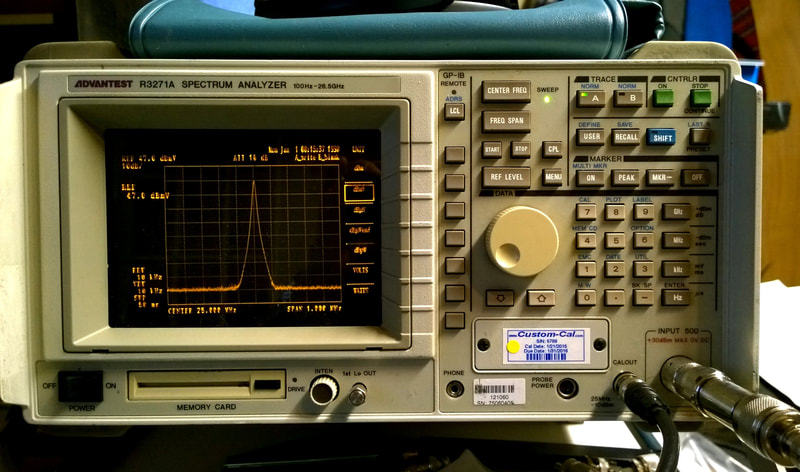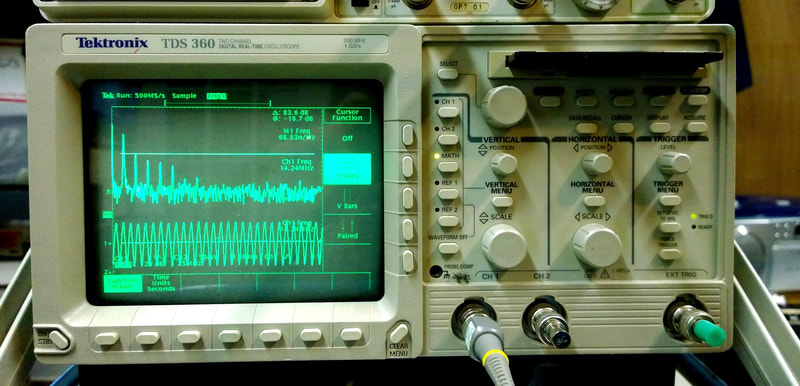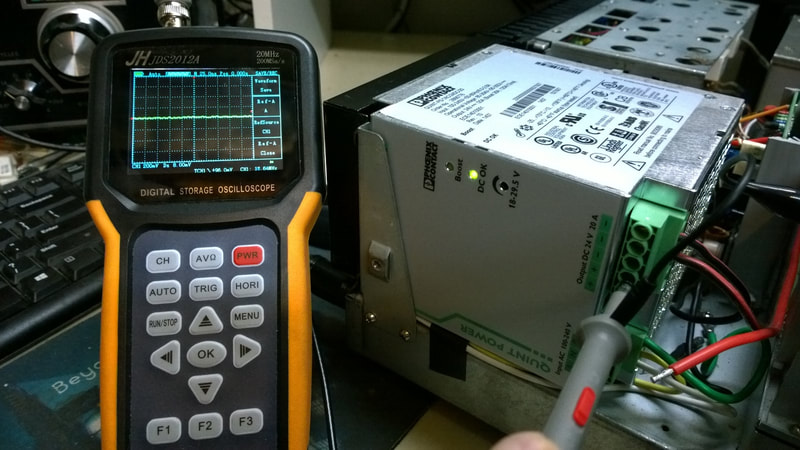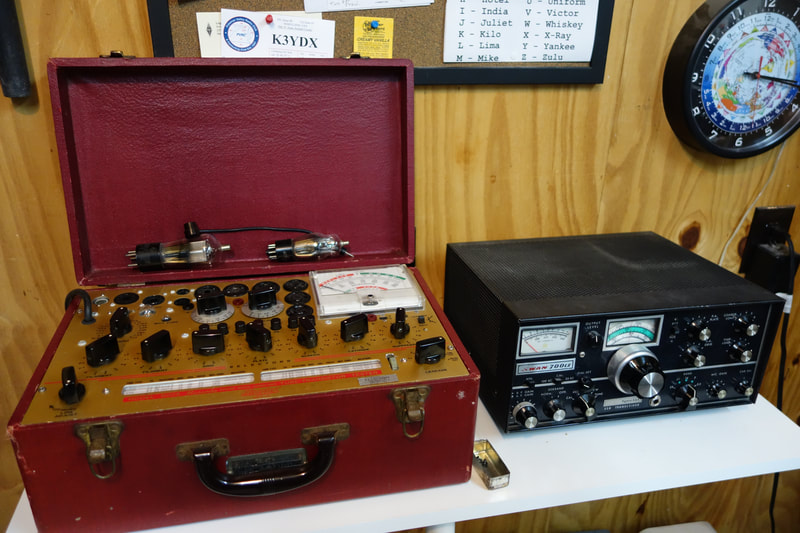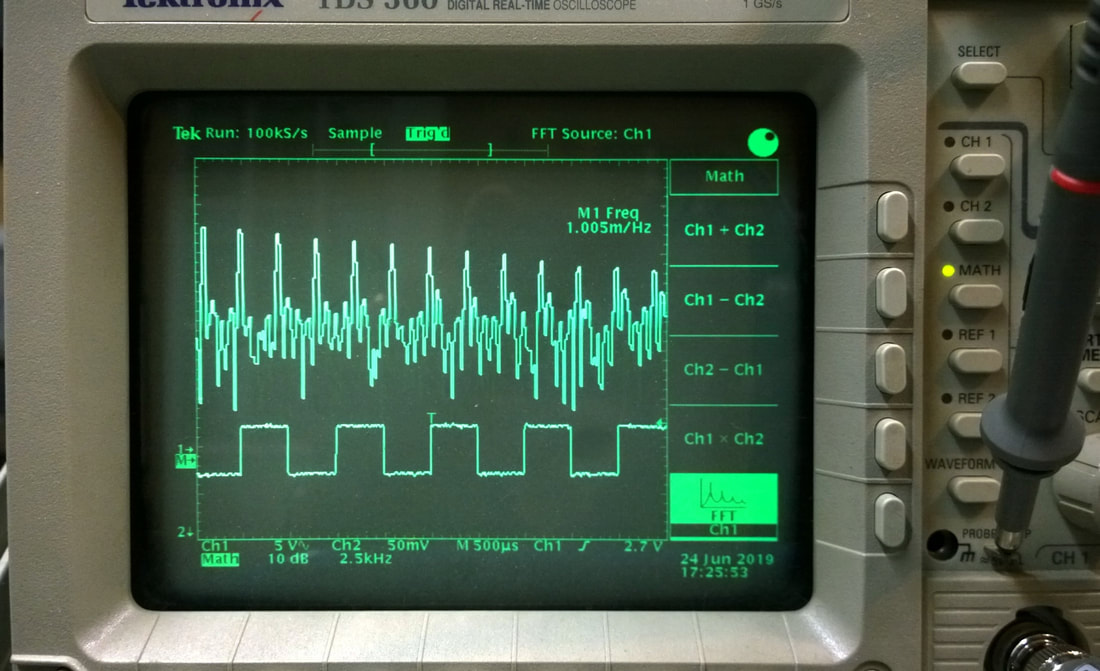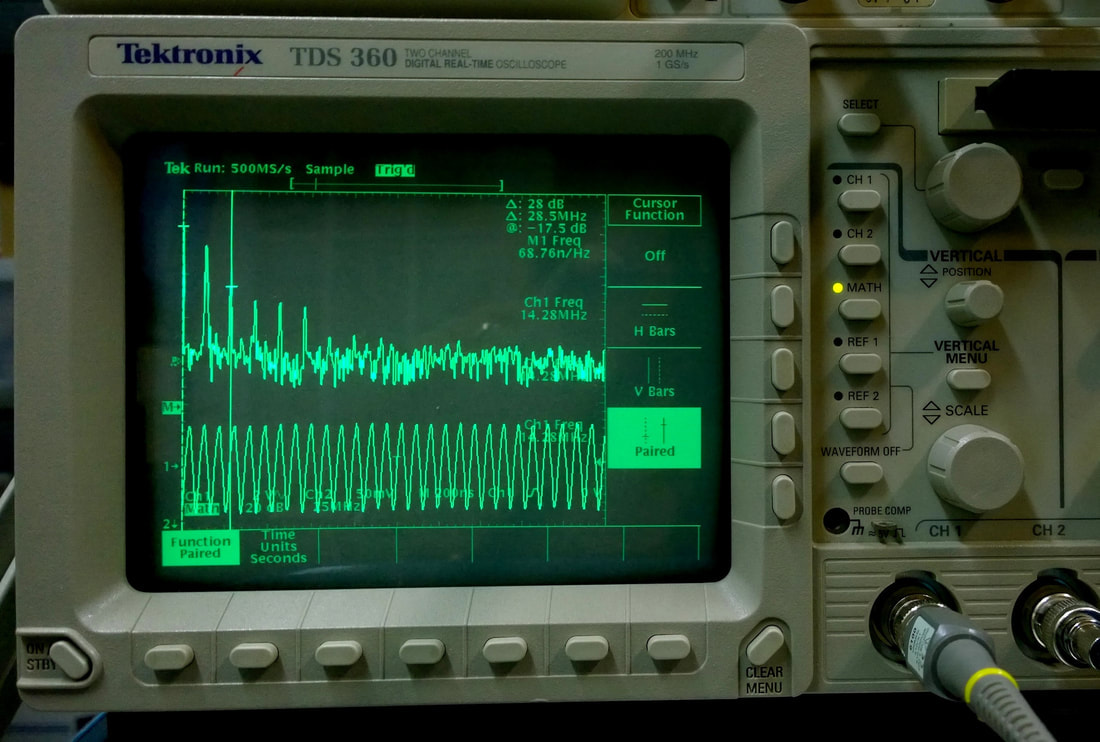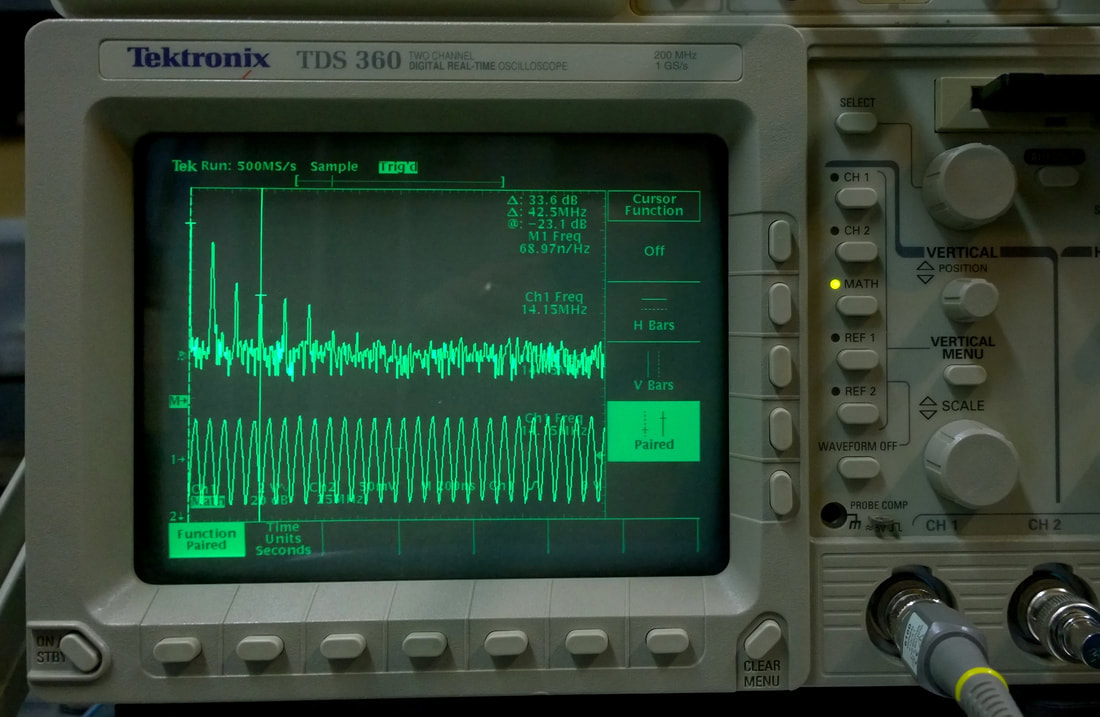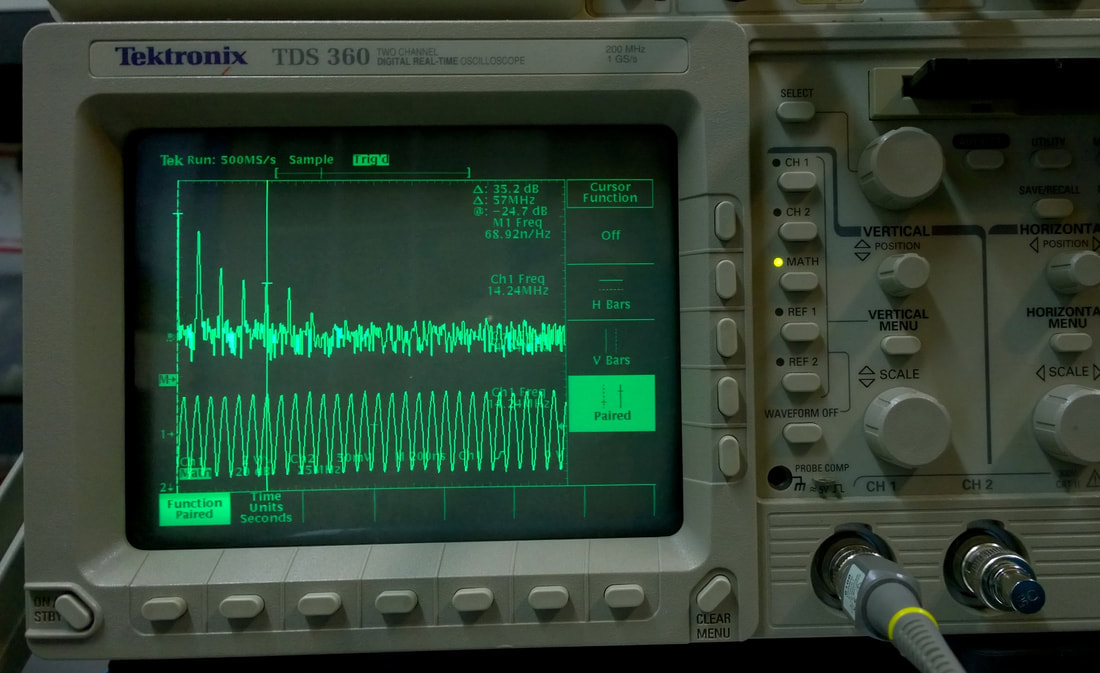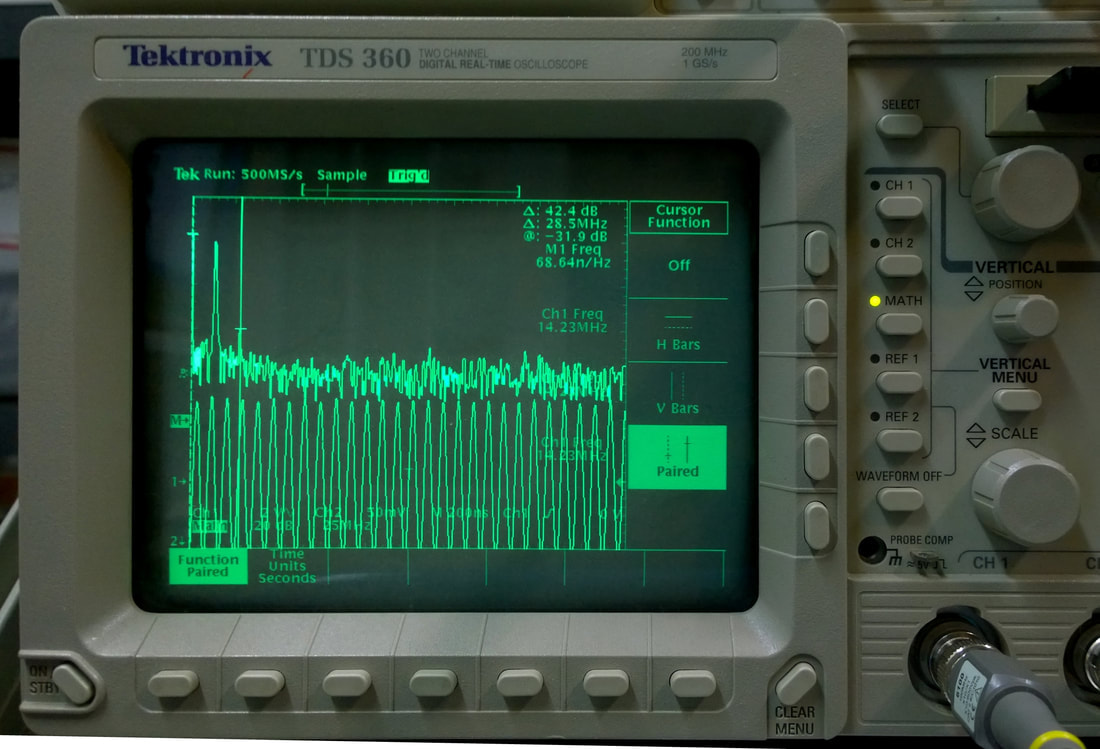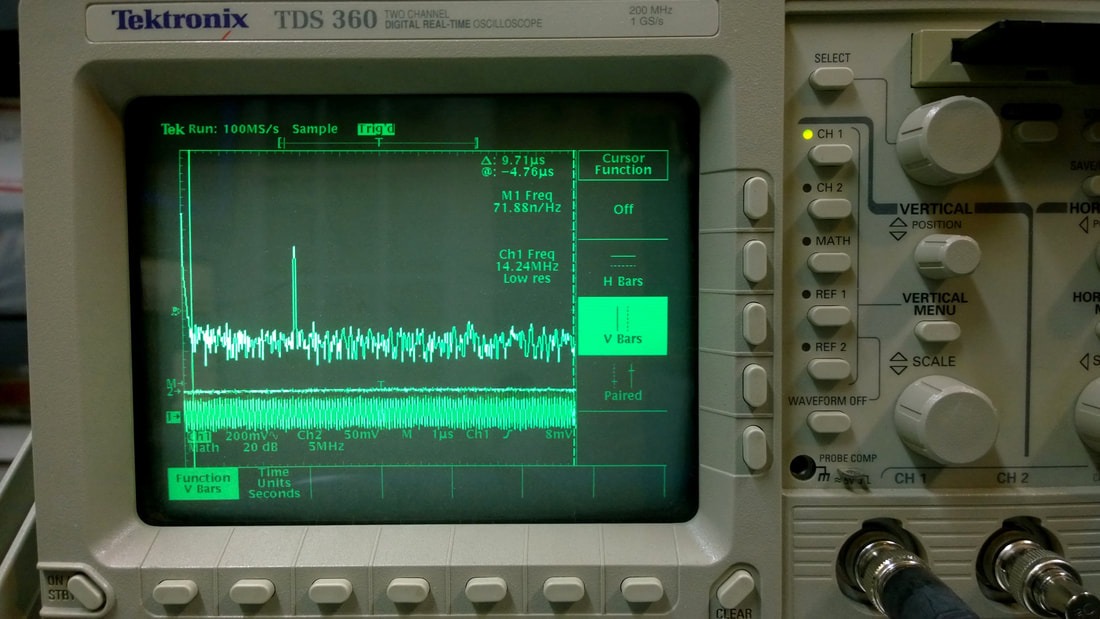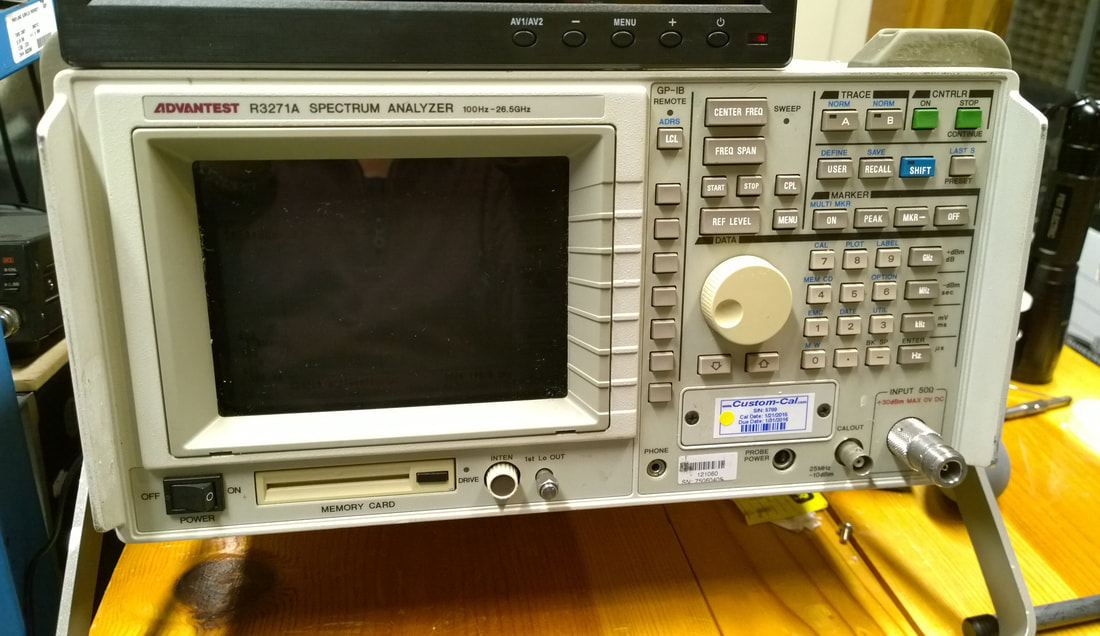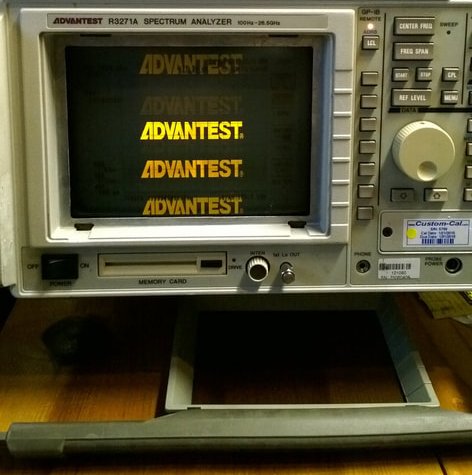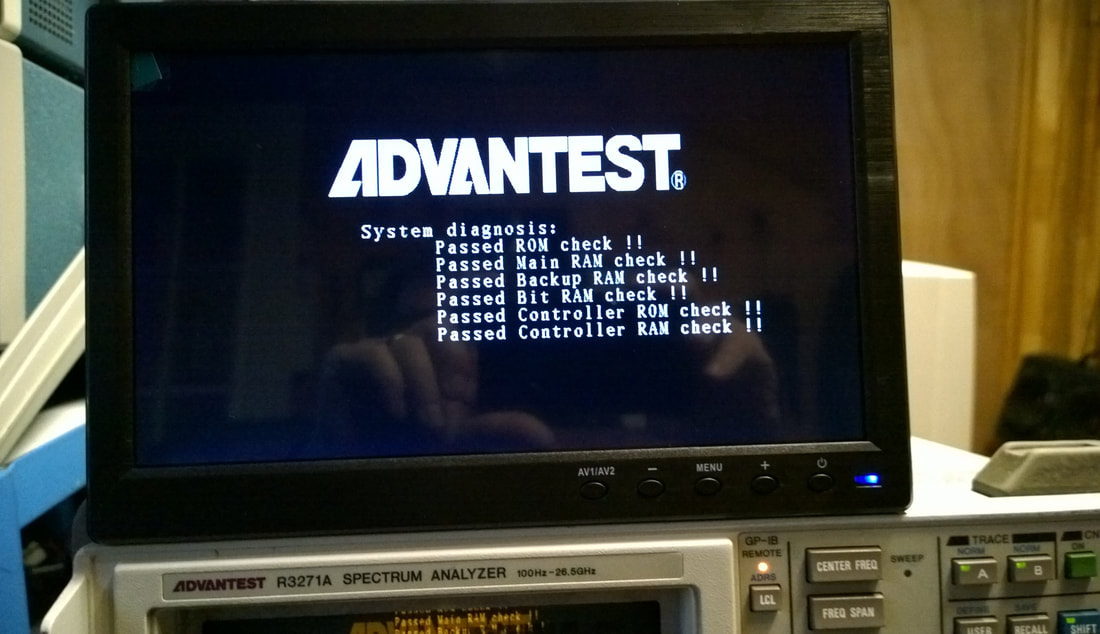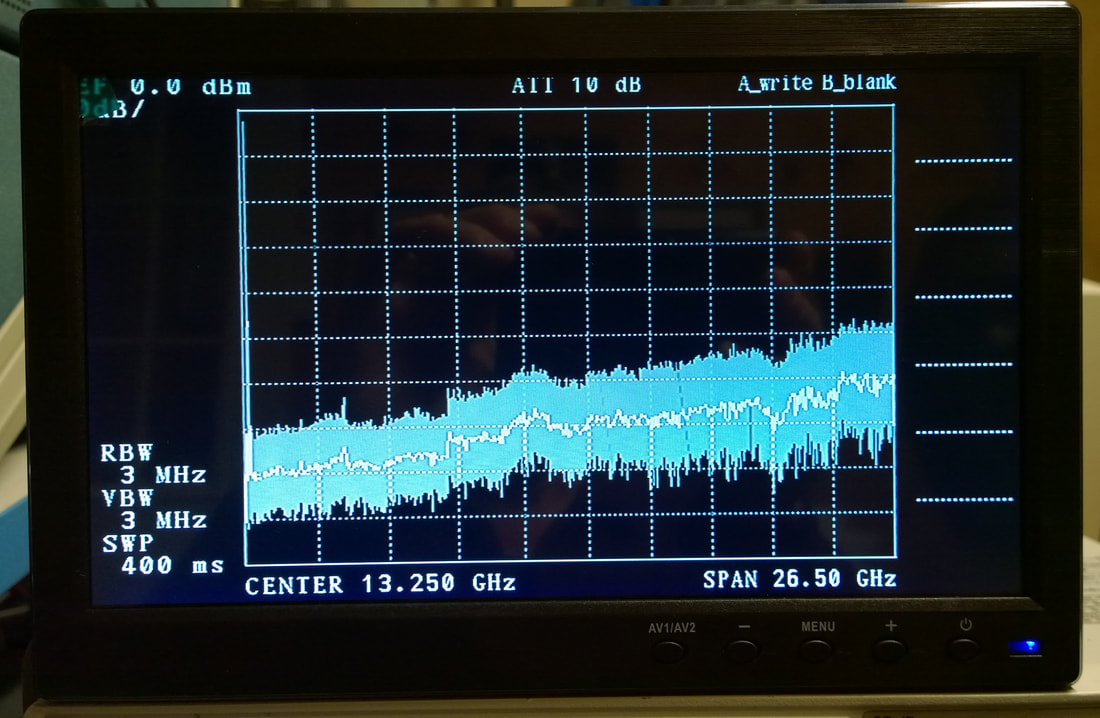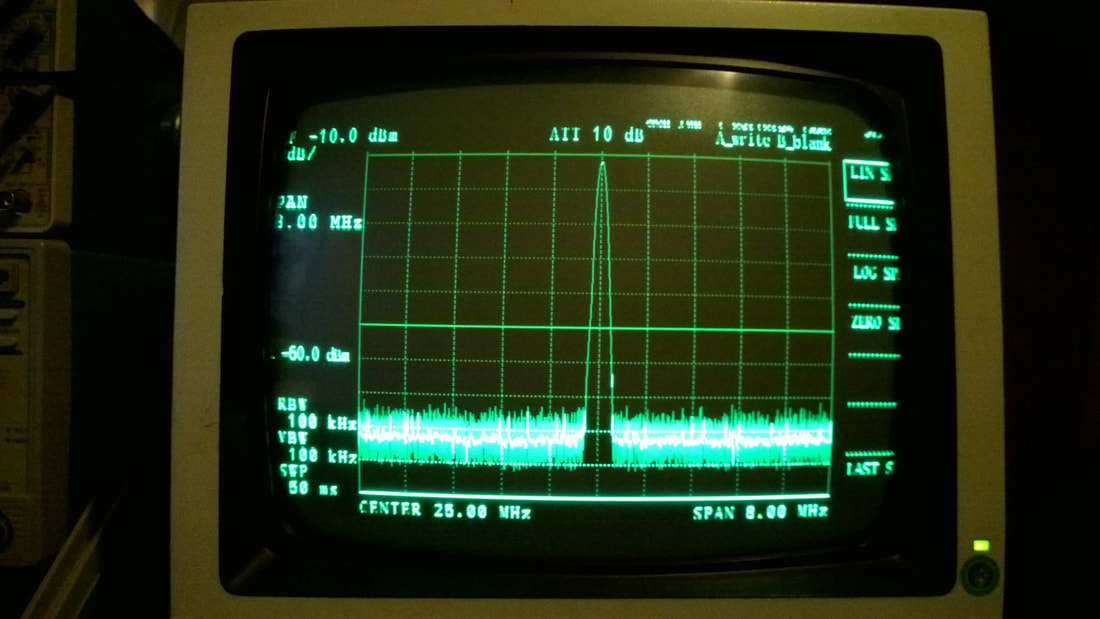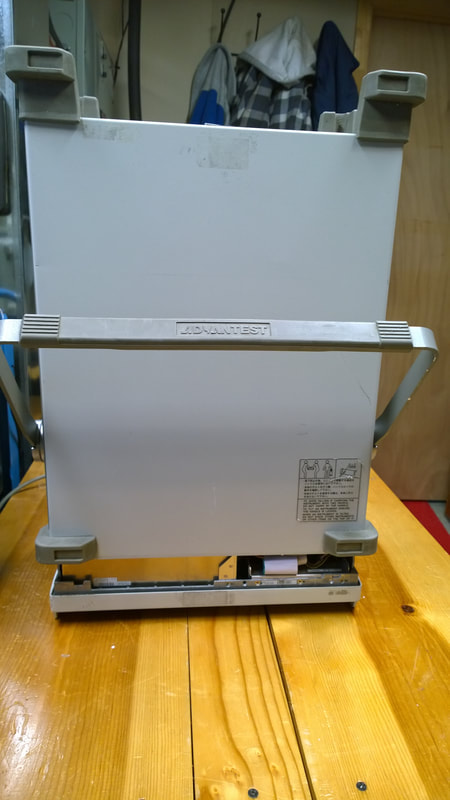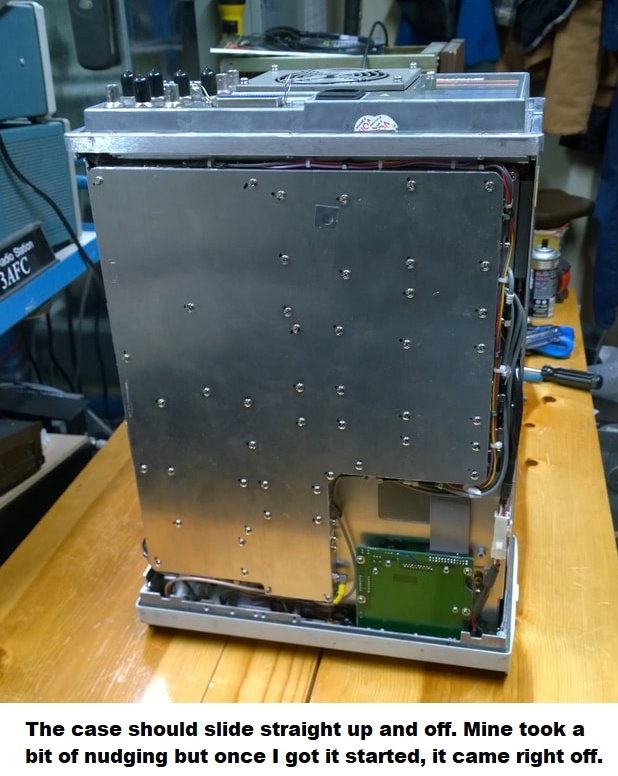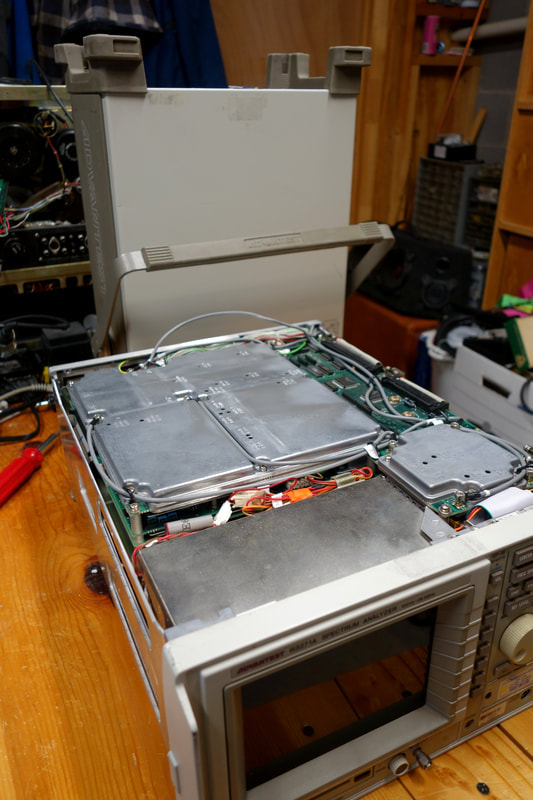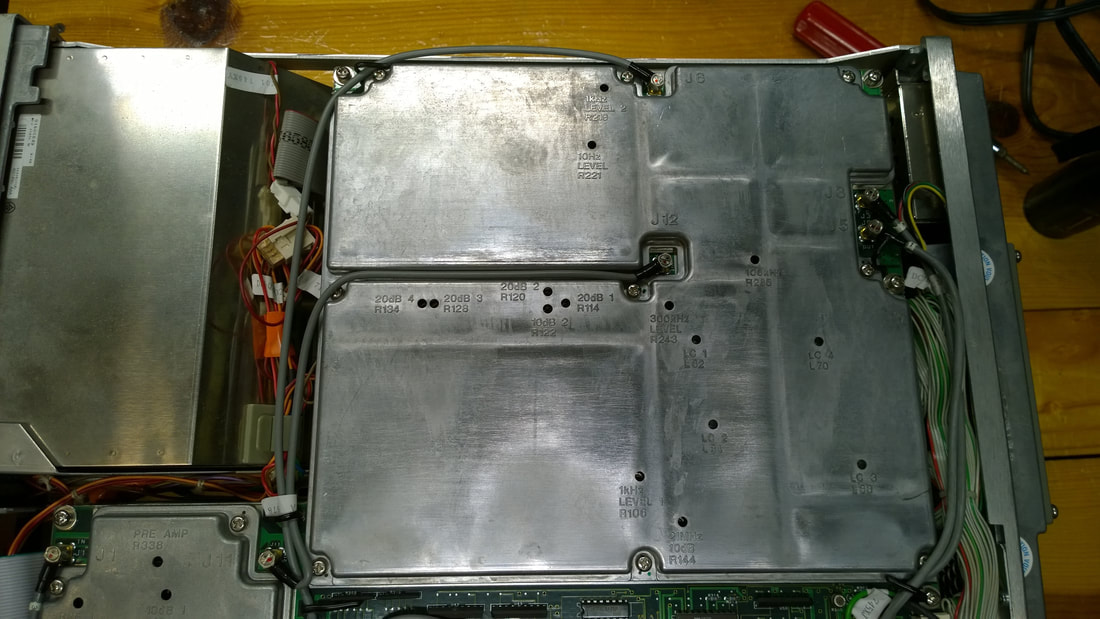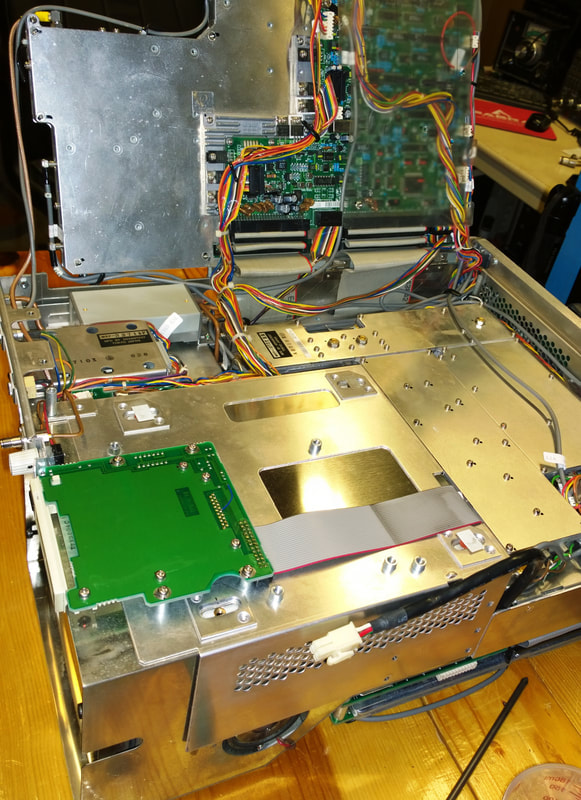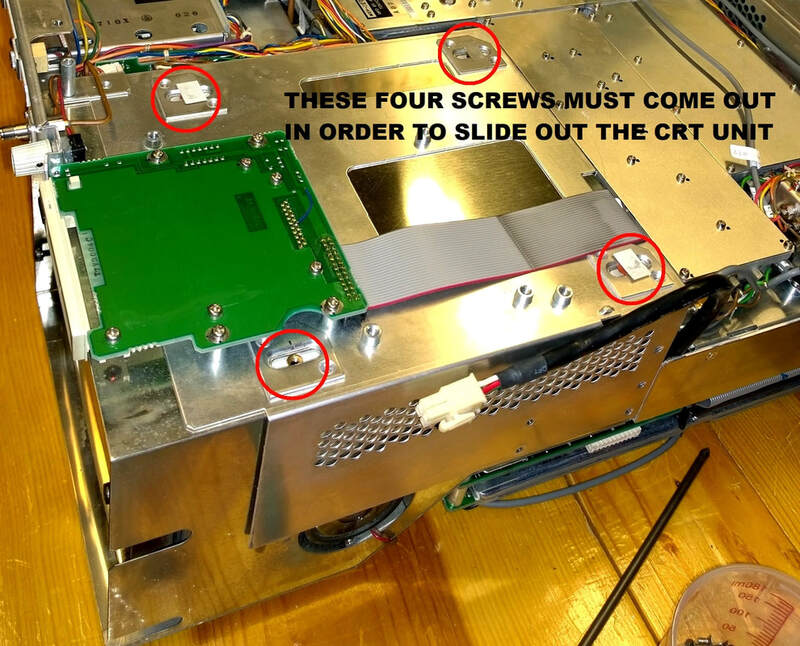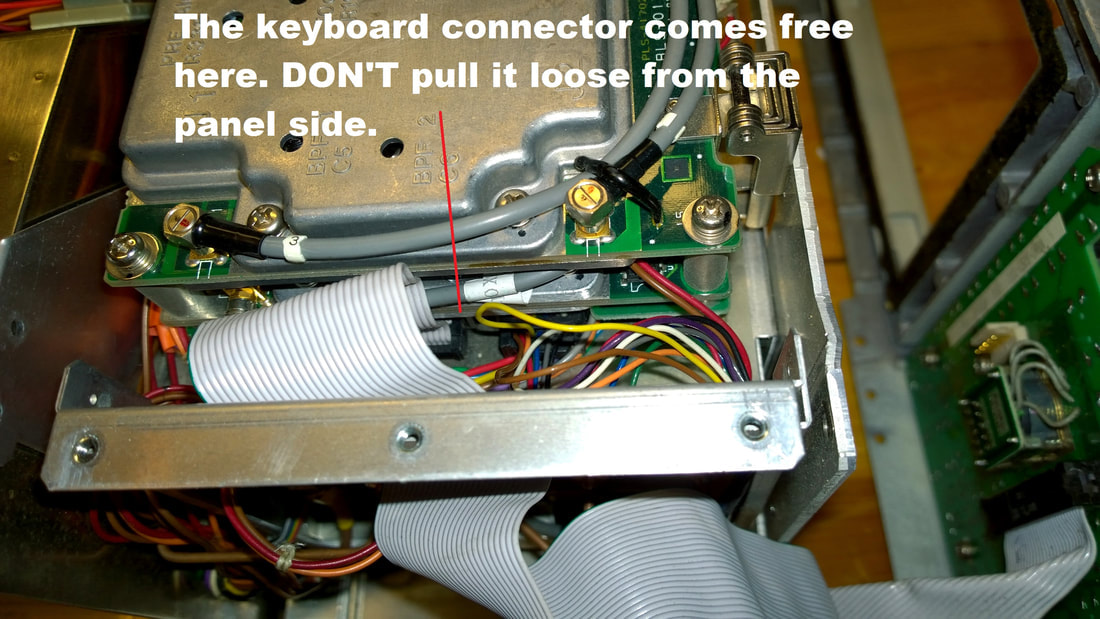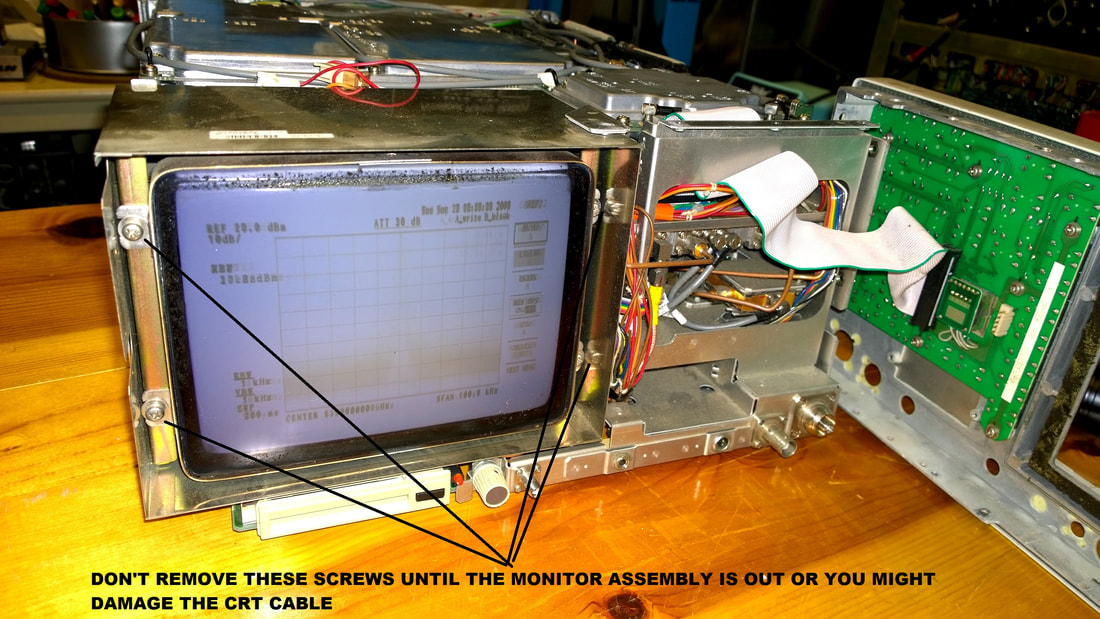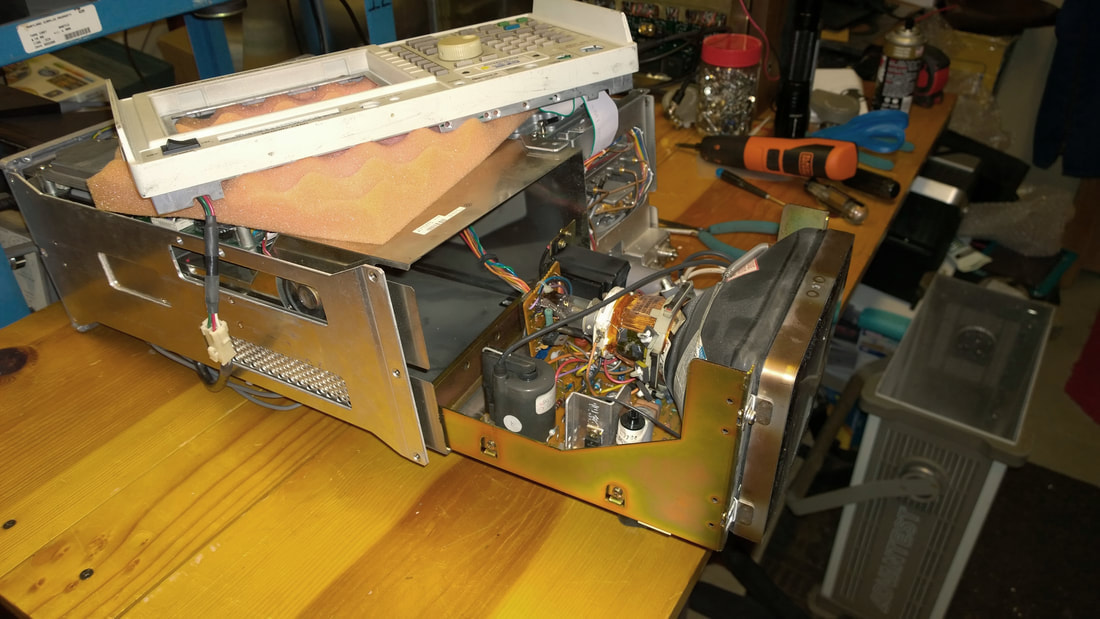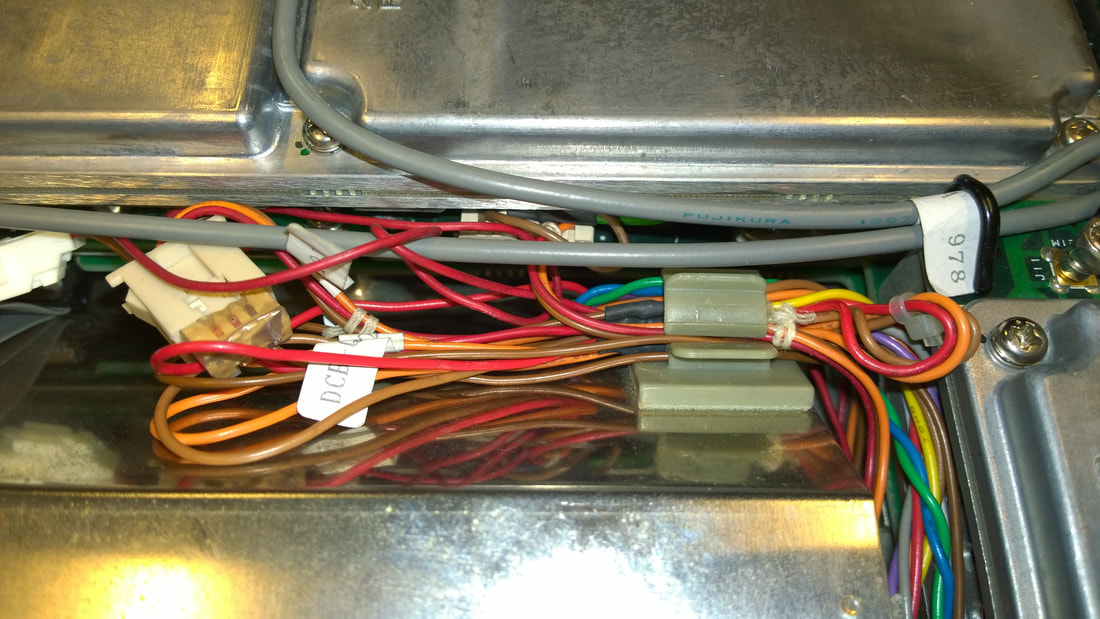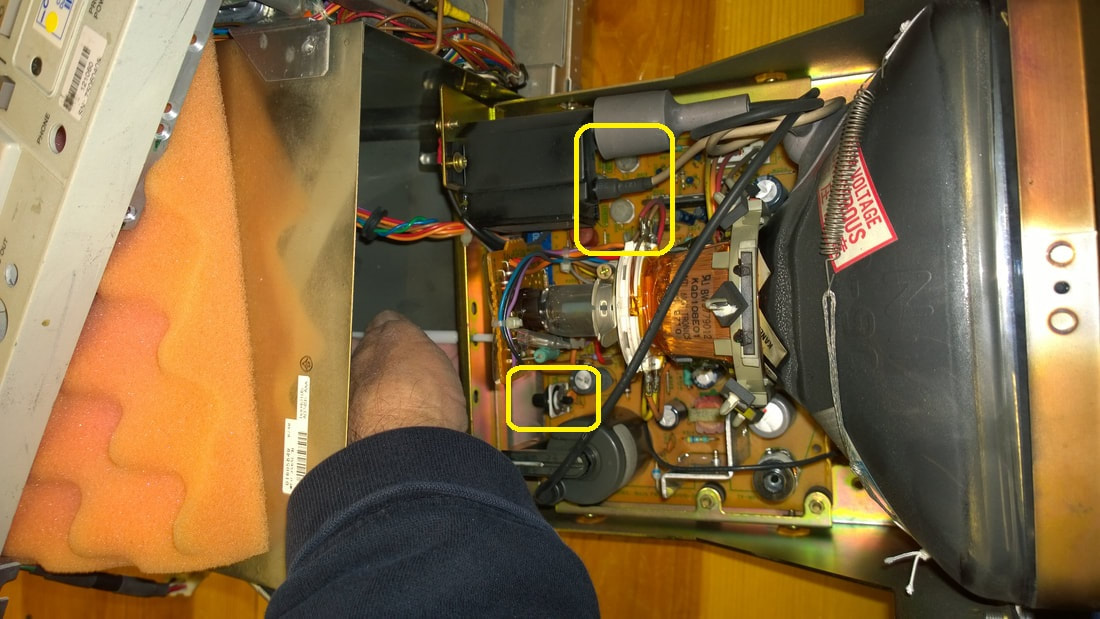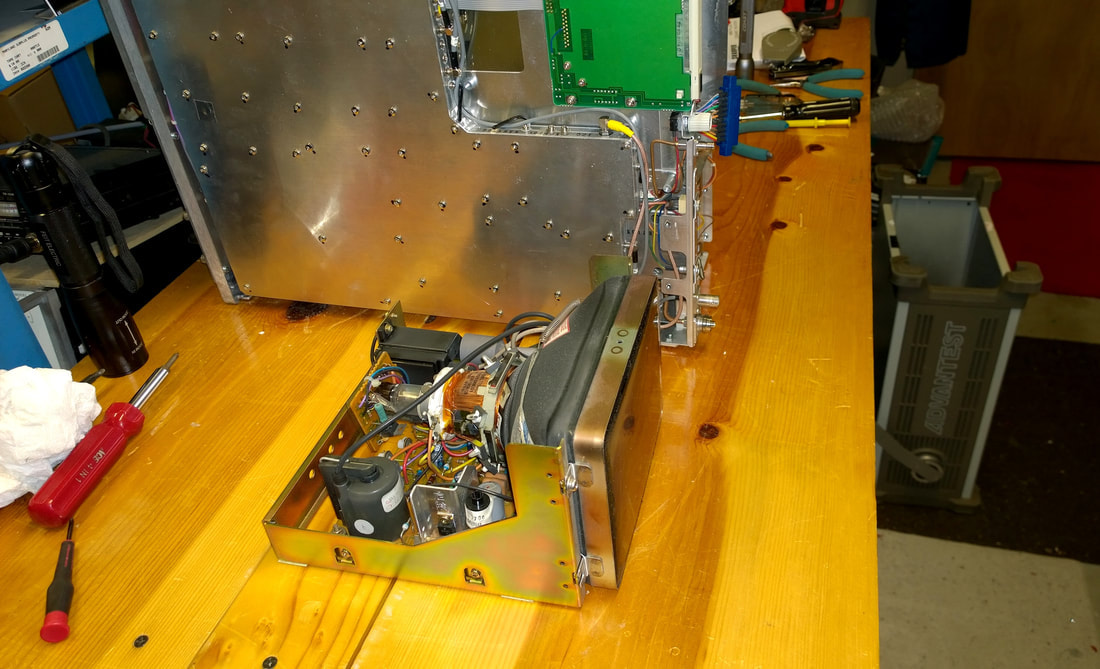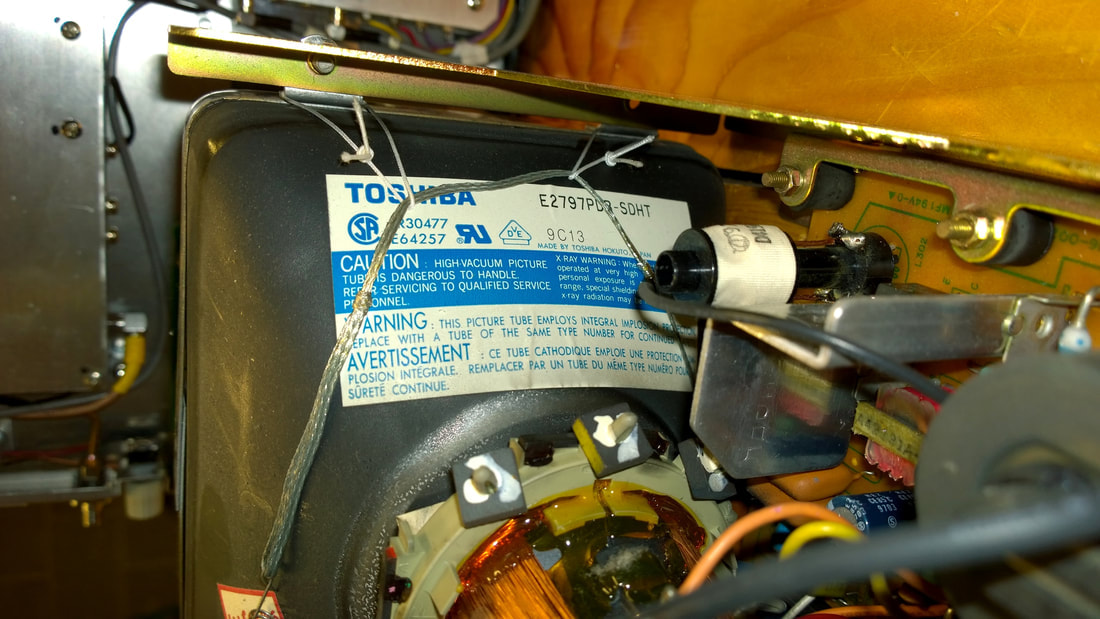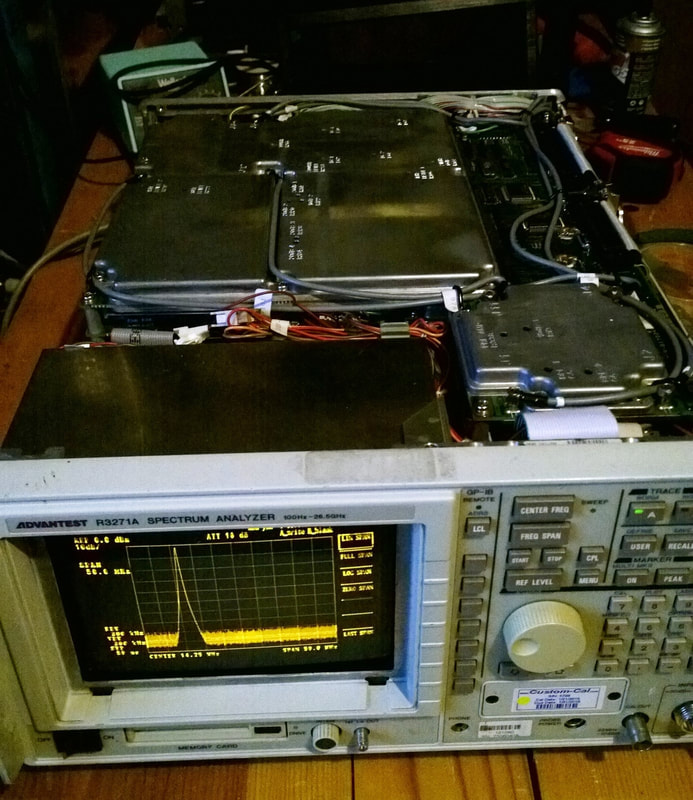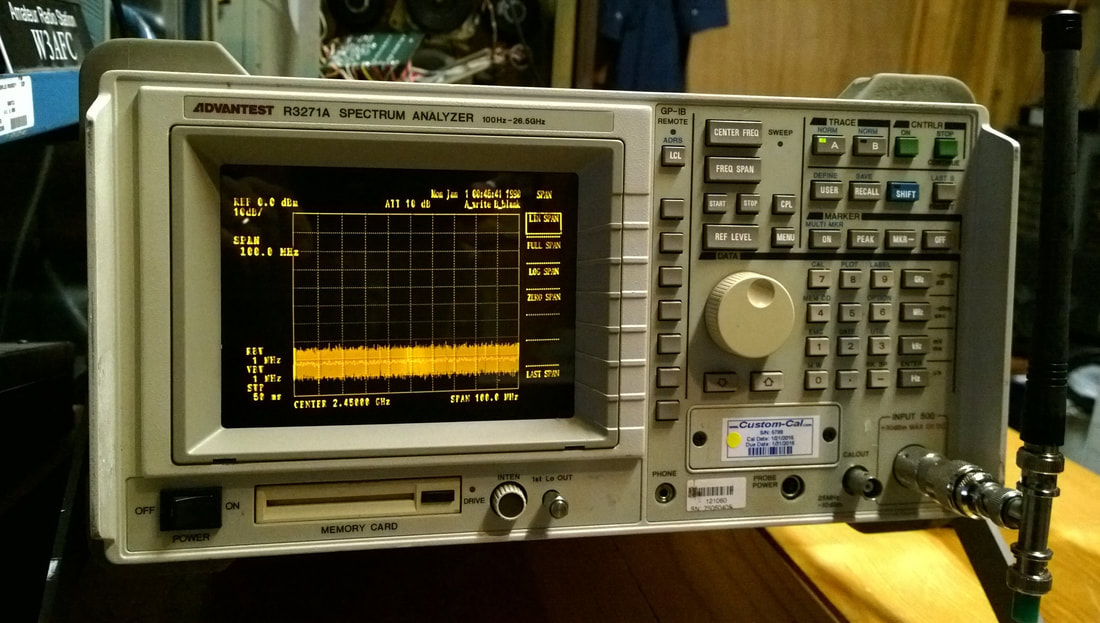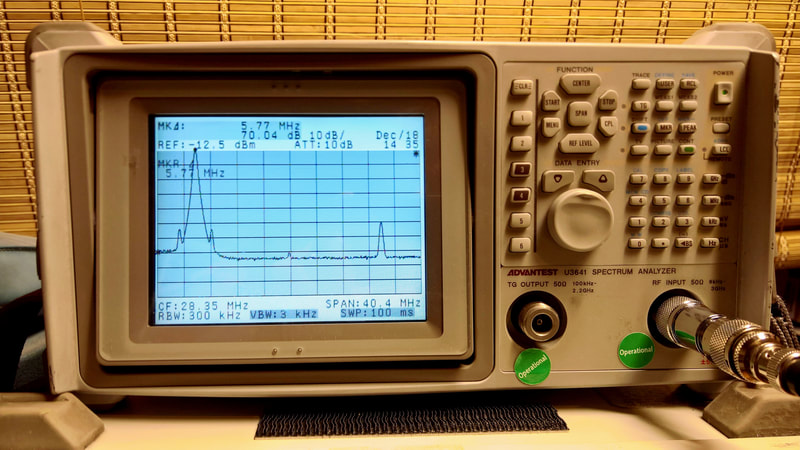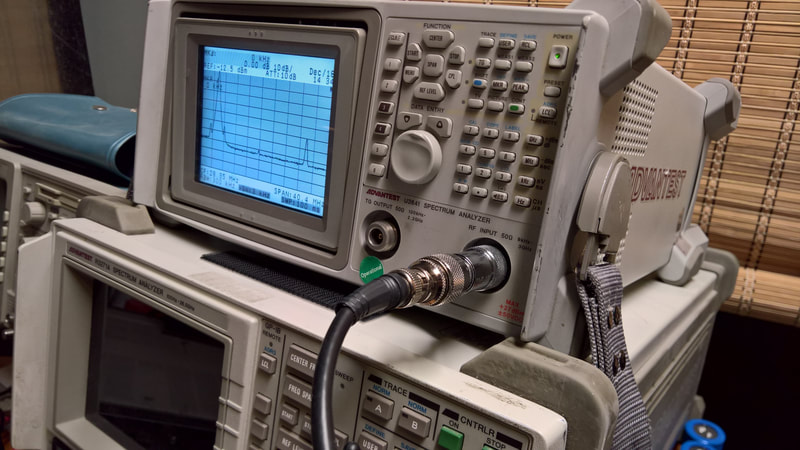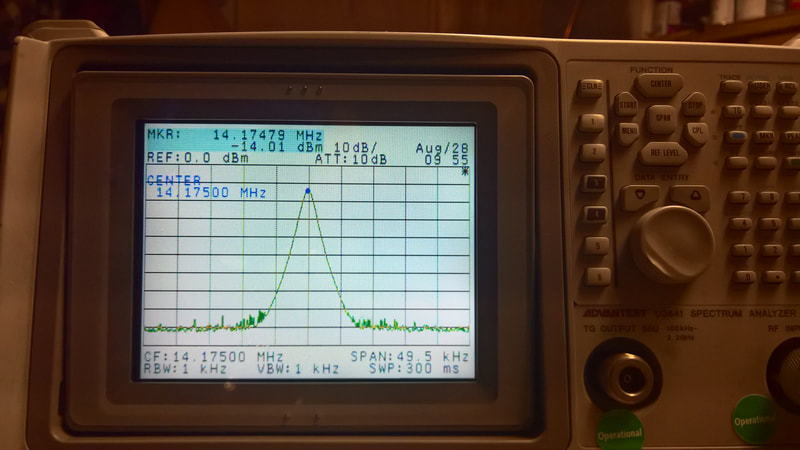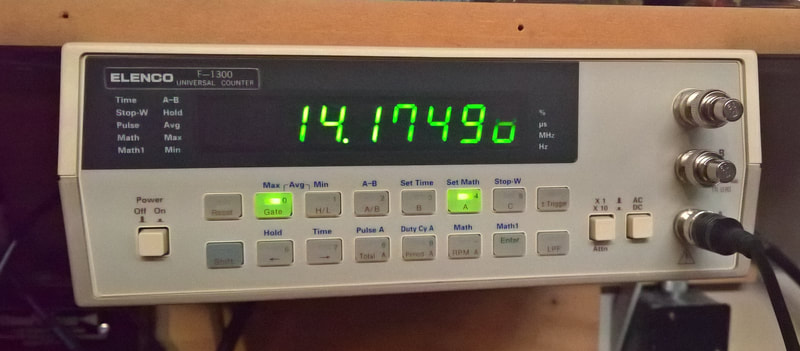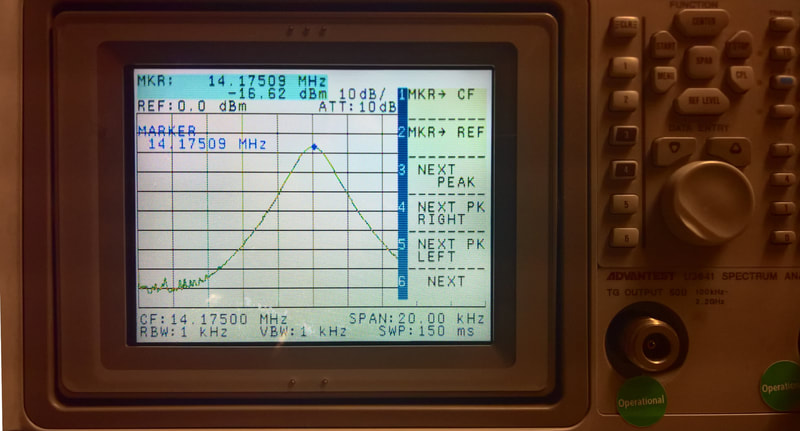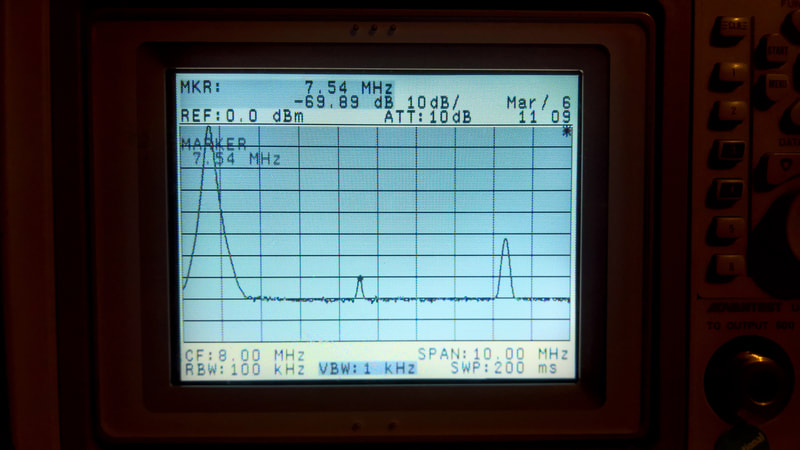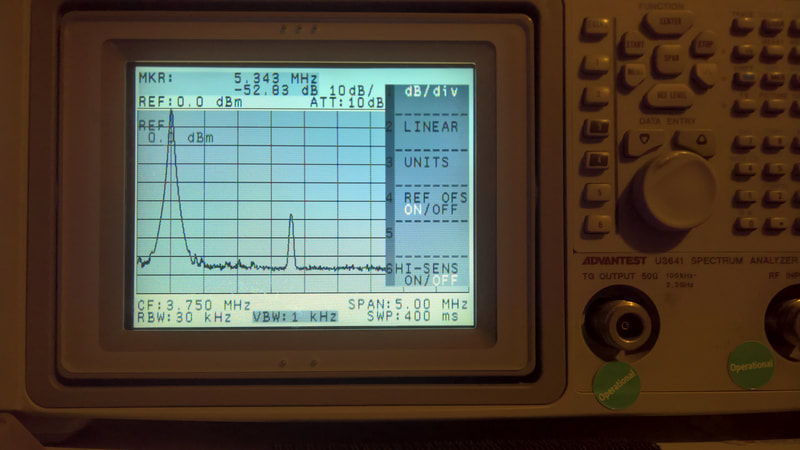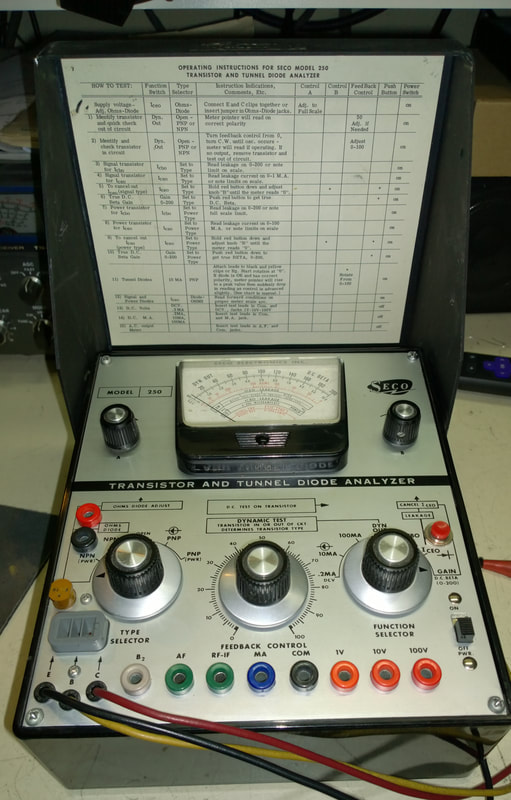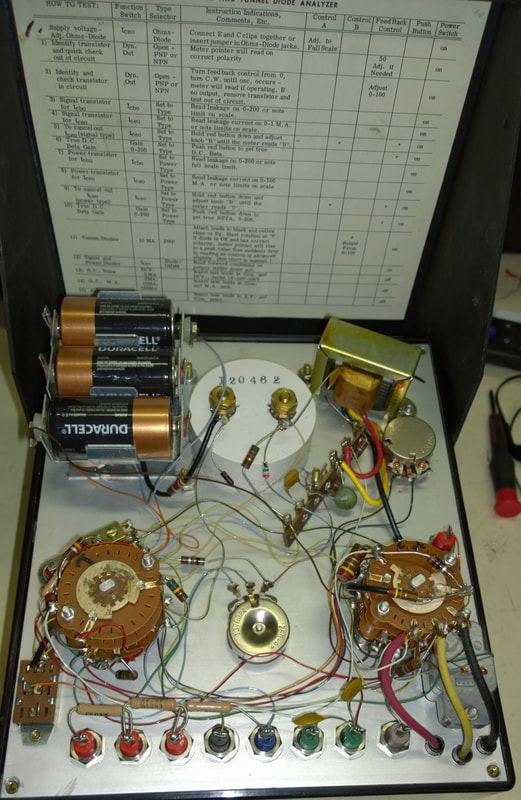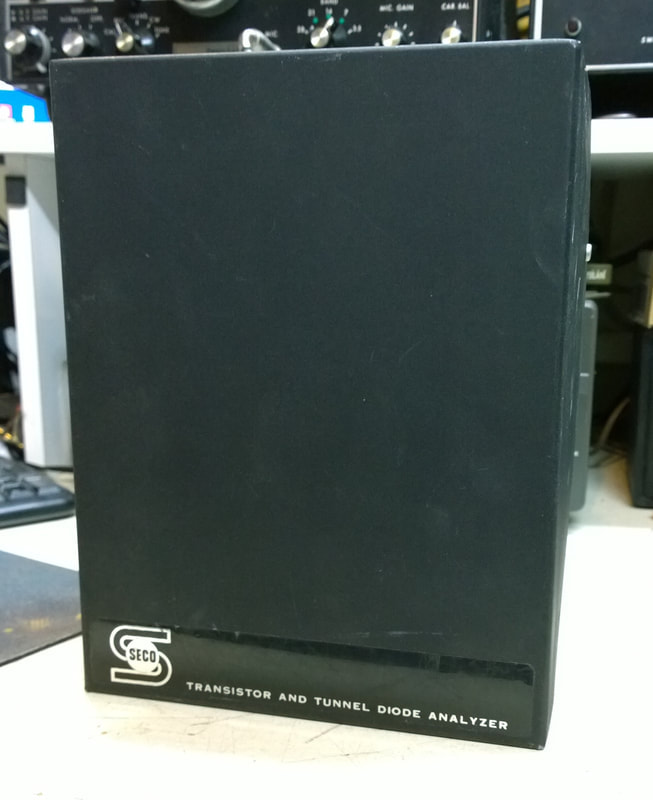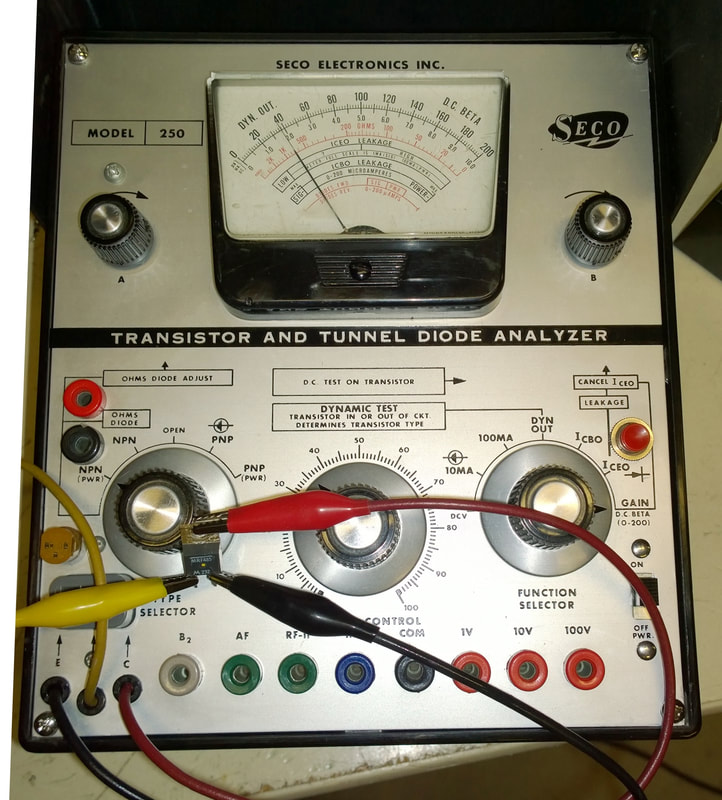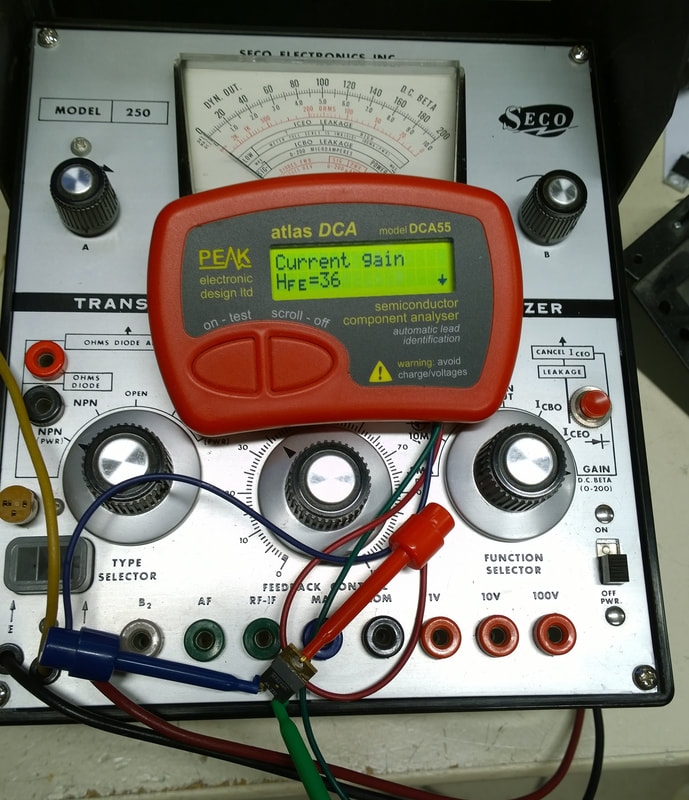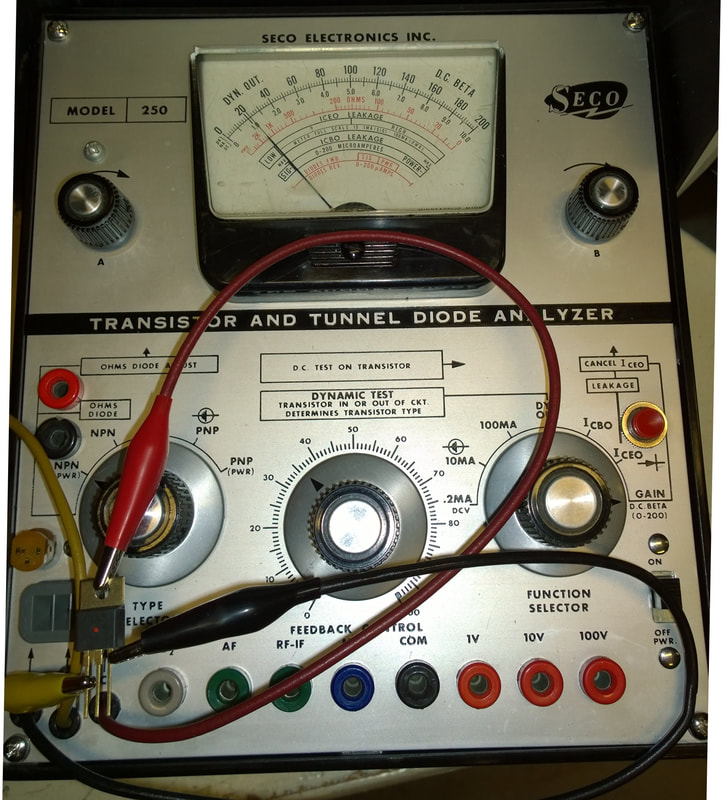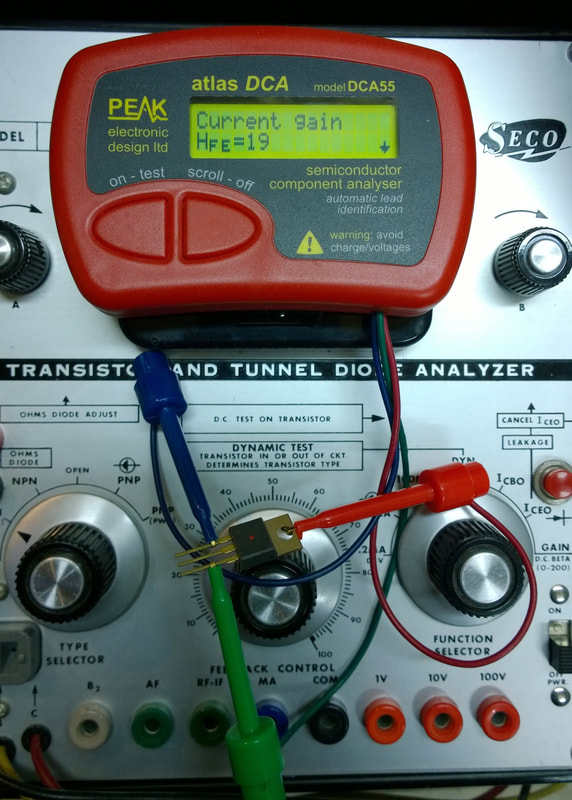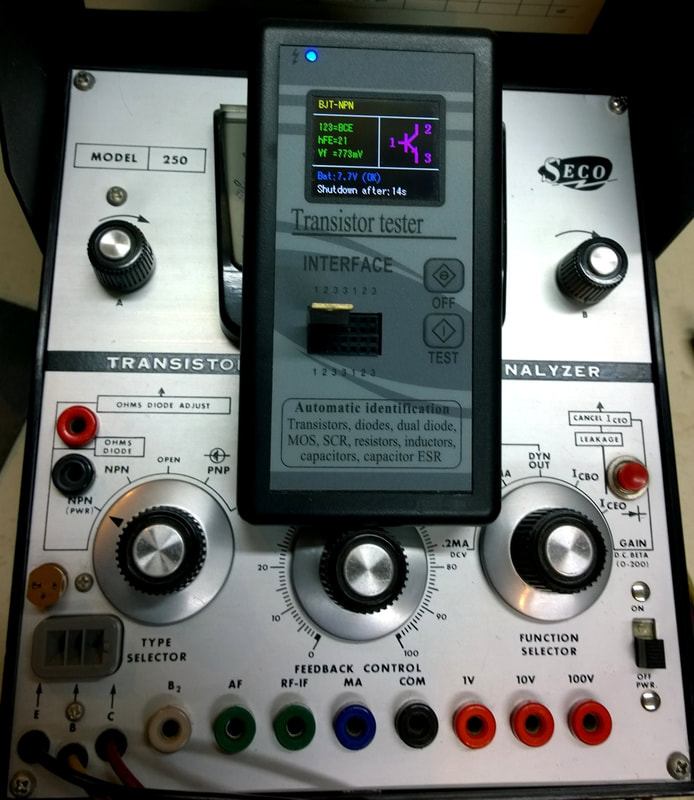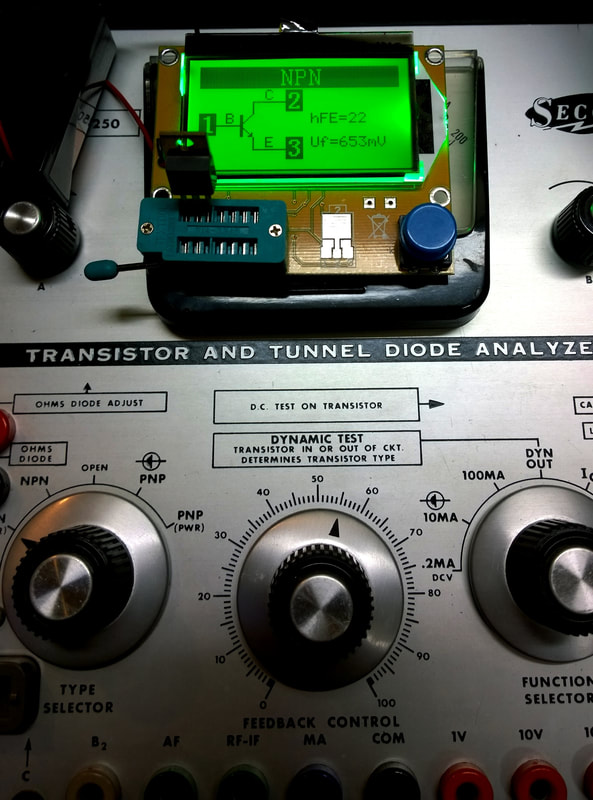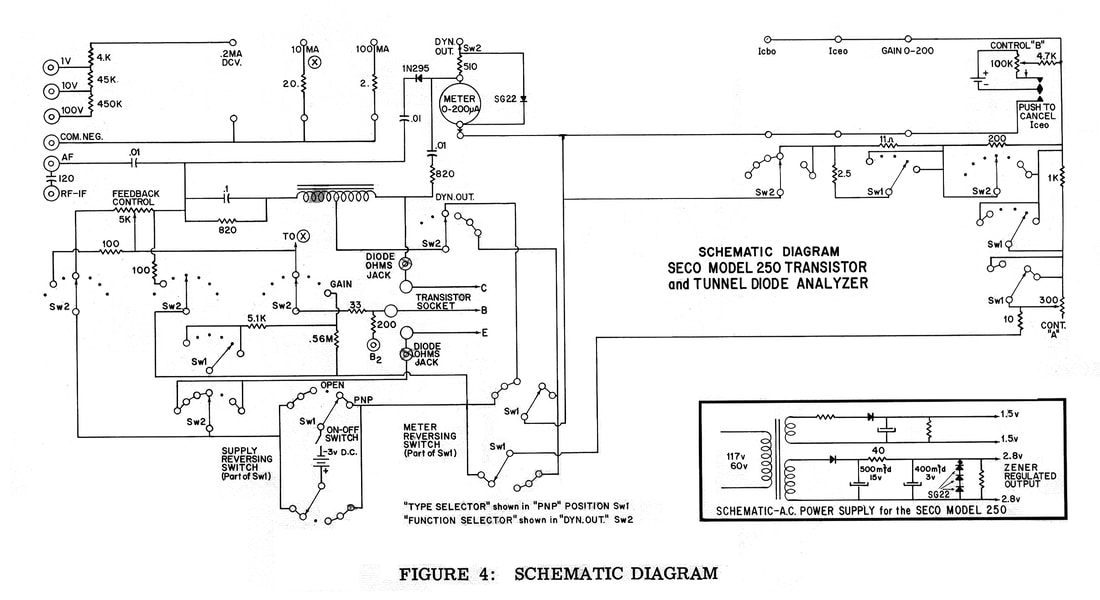TEST EQUIPMENT
SPECTRUM ANALYZERS, SCOPES, TESTERS, AND OTHER STUFF
TEK TDS 360: A CLASSIC SCOPE WITH FFT (SPECTRUM ANALYZER)
One advantage to a using a scope with FFT is that you can simultaneously display the waveform and the spectral display (FFT), plus the input signal level permitted by a scope is generally much higher than that of a Spectrum Analyzer (SA). Of course FFT is crude compared to a dedicated SA, and the SA has much better resolution, but if you can't afford both instruments go for something like the Tektronix TDS 360 shown here. They can be found on eBay for $150 or so. Whatever you get, pick something with a high bandwidth and a fast sampling rate.
Despite being so old that it has a floppy disk drive for storage (LOL), the 360 has a bandwidth of 200 MHz, which yields a spectrum analyzer (FFT) with a range up to 100 MHz. Also, the 360 has a competitive sampling rate of 1 GS/s (gigasamples/second). You can get new LCD DSO's for under $400 but be sure to choose a scope with a bandwidth that's twice the spectrum analyzer frequency range that you need. For example, my TDS360 can give a decent "off-air" spectral display with a rubber antenna with all my transmitters, including my 6-meter Swan 250. The pix below have captions to explain what's going on.
The TDS360 lets the user set different scale sensitivities for the Scope and Math (FFT) displays. That makes it easy to get the two displays on the same screen. Also, you can set the cursors to a "paired" mode so that you get the frequency and the dB all at once.
The faint vertical bars you might see in the pictures below are reflections from the fluorescent lights in my shack.
Despite being so old that it has a floppy disk drive for storage (LOL), the 360 has a bandwidth of 200 MHz, which yields a spectrum analyzer (FFT) with a range up to 100 MHz. Also, the 360 has a competitive sampling rate of 1 GS/s (gigasamples/second). You can get new LCD DSO's for under $400 but be sure to choose a scope with a bandwidth that's twice the spectrum analyzer frequency range that you need. For example, my TDS360 can give a decent "off-air" spectral display with a rubber antenna with all my transmitters, including my 6-meter Swan 250. The pix below have captions to explain what's going on.
The TDS360 lets the user set different scale sensitivities for the Scope and Math (FFT) displays. That makes it easy to get the two displays on the same screen. Also, you can set the cursors to a "paired" mode so that you get the frequency and the dB all at once.
The faint vertical bars you might see in the pictures below are reflections from the fluorescent lights in my shack.
ADVANTEST R3271A SPECTRUM ANALYZER
UPDATE!
The upper range of this device can reach a center frequency almost 5 GHz above the stated range (31.3 GHz). This is not uncommon with high grade test equipment. For instance, my Tektronix Scopes have upper frequency limits that are much higher than the stated range of the equipment. Typically, there's a slight drop-off in the response, but it isn't significant if the increase is only 10-20 percent.
I'm not sure how accurate my R3271A will be above 26.5 GHz, but I will be using this for comparing two signals in the same frequency range (K and Ka-band microwave) so the absolute accuracy will not be critical. For one thing, I don't have a calibrated antenna for that range, although I have found some that respond well in the upper ranges.
One of the reasons that I bought this analyzer is that I want to compare the signal intensity of one of those 5G "Small Cell" stations to that of a commonly-used Police radar gun, the Falcon K-gun. The problem is that the announced frequency ranges for K-band 5G are slightly higher than 26.5 GHz. However, they are lower than 30 GHz, so I should be able to use this piece of equipment for my study.
The upper range of this device can reach a center frequency almost 5 GHz above the stated range (31.3 GHz). This is not uncommon with high grade test equipment. For instance, my Tektronix Scopes have upper frequency limits that are much higher than the stated range of the equipment. Typically, there's a slight drop-off in the response, but it isn't significant if the increase is only 10-20 percent.
I'm not sure how accurate my R3271A will be above 26.5 GHz, but I will be using this for comparing two signals in the same frequency range (K and Ka-band microwave) so the absolute accuracy will not be critical. For one thing, I don't have a calibrated antenna for that range, although I have found some that respond well in the upper ranges.
One of the reasons that I bought this analyzer is that I want to compare the signal intensity of one of those 5G "Small Cell" stations to that of a commonly-used Police radar gun, the Falcon K-gun. The problem is that the announced frequency ranges for K-band 5G are slightly higher than 26.5 GHz. However, they are lower than 30 GHz, so I should be able to use this piece of equipment for my study.
PURCHASE RATIONALE
The more I used my FFT function, the more I yearned for an actual Spectrum Analyzer (SA). If you work on RF equipment like HAM radios, this is definitely a "need" and not a "want". And the more I researched models and features, the more I succumbed to "salami theory". Why buy a SA with a range of 9KHz to 1.5 GHz for $600 when for just $100-$200 MORE I can have one that goes to 13.5 GHz. No, wait! For another $150 I can get one that goes from 100 Hz to 26.5 GHz! Or for a mere $2,500 more I could get one that goes from 30 Hz to 26.5 GHz (HP8563A with all the right options). You get the idea. I had to draw a line somewhere so I drew it at $800-$1,000.
Thanks to NES Sales (travist_tech on eBay), I didn't have to spend that much. They're an electronics salvage/recycle company, and they're in a building in an industrial complex - they're not some guy operating out of his basement or garage. They had several Advantest R3271A's for $800 or Make Offer, pulled from a working environment. Also, they have a 30-day return policy. I made an offer, and they accepted. The SA arrived super well-packaged, but somewhere along the line the vertical hold got knocked out of adjustment. There's a control on the CRT board for that, but it's not on the back of the unit - it's buried deep inside. The built-in screen was impossible to read, so to be sure the device worked from an electronic standpoint, I connected an external monitor. It passed all POST tests and the panel buttons and all functions worked great. They offered to refund even more of my payment rather than have me ship it back (thank God - it's crazy heavy). Seriously, they were super easy to work with, so they're on my Favorite Seller list now.
NOTE: I think the eBay seller has run out of stock, as a reader who bought one did not have the good fortune I had. I had that model on my watch list, and apparently I got one of the early ones. I use mine almost daily, and it works great.
My plan was to use an external monitor until some snowy day when I had time to dig into this and fix the vertical hold problem. But I was impatient and on the first rainy day, I tore into it and fixed it. Check out the new set of photos below.
This will be a very useful tool for analyzing the output from the various TS-930S Power Amp options. I just need to read the instructions - all 600+ pages of them.
ADVANTEST U3641 SPECTRUM ANALYZER
The more I used my R3271A SA, the more I yearned for something lighter that could be carried around if necessary. In addition, I wanted one with a built-in Tracking Generator. Those two criteria led me to the Advantest U3641. This unit has a color LCD tilting screen that can be configured in so many ways that one could spend an entire afternoon setting up screen colors alone. There are separate menus for everything one could imagine. I'll post some pictures of some of them. The nice thing is that they are fairly intuitive. The manual is organized logically so that one can find out how to perform various tests quickly. And my model was tested, and even better, it has a built-in Tracking Generator (TG). Don't buy an SA without a TG.
The U3641 can operate on a battery pack, a car cord, or the AC line. Some accessories are hard to find because like the R3271A, the U3641 is an older model. But at 22 lbs it's a third as heavy as my R3271A, and it's easier to use and it boots and performs self-tests much faster. For HAM radio, this is my "go-to" SA now. More to come on this model, but here are some pictures.
The U3641 can operate on a battery pack, a car cord, or the AC line. Some accessories are hard to find because like the R3271A, the U3641 is an older model. But at 22 lbs it's a third as heavy as my R3271A, and it's easier to use and it boots and performs self-tests much faster. For HAM radio, this is my "go-to" SA now. More to come on this model, but here are some pictures.
SECO 250 TRANSISTOR TESTER
If you work on radios like the TS-930S, a transistor tester is as essential to your work as a tube tester is to a vintage radio restorer. And like tube testers, transistor testers can show wide variations in test results.
Some testers are afterthoughts, a simple socket on a DMM with an hFe position on the dial. I have three or four of those and they're inaccurate. The hFe (Beta) reading I get with those is about half of the actual gain.
Others are super neat-looking, like the SECO 250 Transistor and Tunnel Diode Analyzer. The more complex units like the Model 250 have lots of knobs and dials and are fun to operate. They usually require that the user know or at least have an idea of what device they are working with, although the 250, as well as ones like the Sencore Super Cricket can identify the type of device under test. Some photos of my new toy are below. It was in unusually clean condition when I bought it.
Some testers are afterthoughts, a simple socket on a DMM with an hFe position on the dial. I have three or four of those and they're inaccurate. The hFe (Beta) reading I get with those is about half of the actual gain.
Others are super neat-looking, like the SECO 250 Transistor and Tunnel Diode Analyzer. The more complex units like the Model 250 have lots of knobs and dials and are fun to operate. They usually require that the user know or at least have an idea of what device they are working with, although the 250, as well as ones like the Sencore Super Cricket can identify the type of device under test. Some photos of my new toy are below. It was in unusually clean condition when I bought it.
One of the cool things about the SECO 250 is its ability to test transistors in circuit. It applies a signal via the "Feedback" control. If the transistor is shorted, open, or just plain dead - the meter won't move. Capacitors and other components around a transistor stage typically won't oscillate. But if the transistor is good, the meter needle will sweep upward and then back down as the transistor oscillates. I'll be testing that feature on an old audio amp and posting the results here.
So far, the 250 is right on target as far as accuracy when compared to the Peak DCA 55 and other testers like the Mega 328. A complete "bake off" will be forthcoming soon. But the pictures below give some indication of it's usefulness. The first driver transistor under test (left two pictures) below is a "yellow dot" Motorola MRF485, which has an advertised hFe (current gain) of 35-40. The last four tests are a Red Dot MRF 485 with a published gain of 18-24.
THE BUTTONS BELOW WILL TAKE YOU TO THE COMPLETE OWNER'S MANUAL WITH A DOWNLOADABLE LARGE VERSION OF THE SCHEMATIC-AND MORE WILL COME LATER. I split the manual into the main section with the instructions and schematic, and a second section which contains transistor data, because the files are so large.
